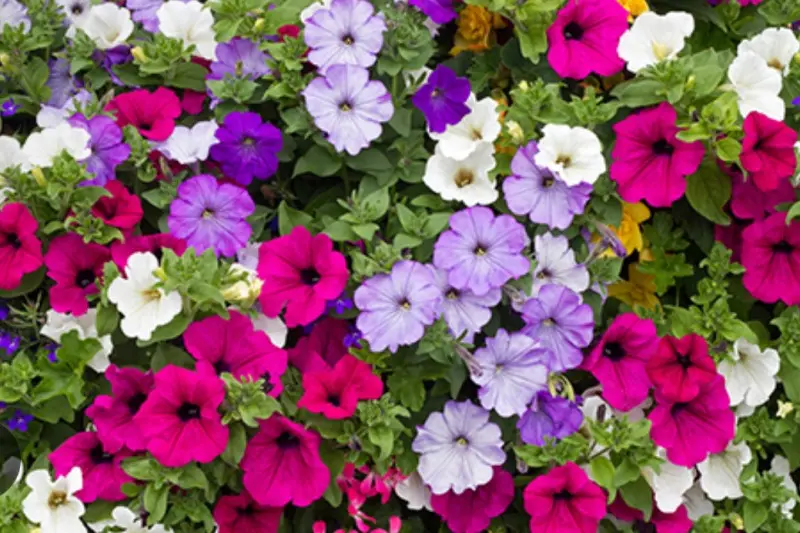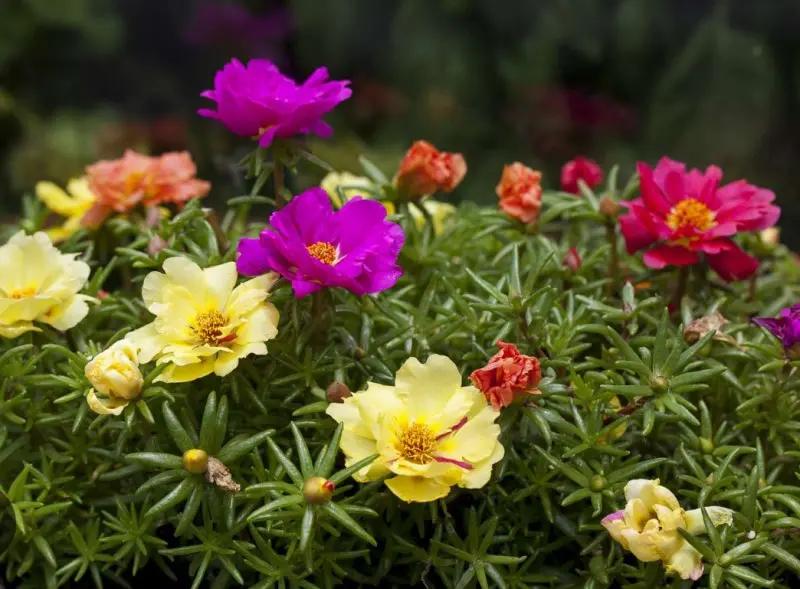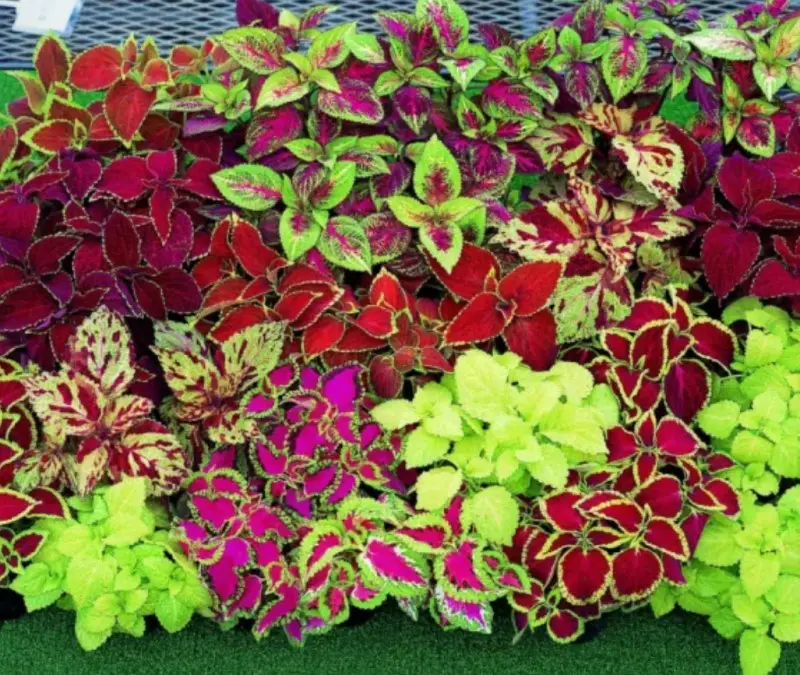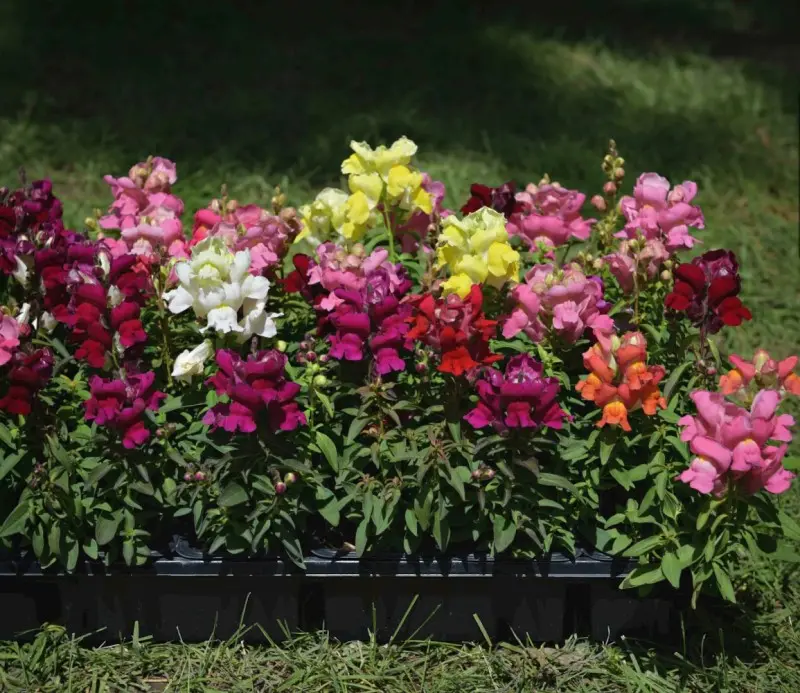-

Petunias
$0.00
Spring/Fall
6 to 18 inches tall
Not Deer Resistant
-
Petunias (Petunia spp.) are popular flowering annuals loved for their colorful, trumpet-shaped blooms and long-lasting display. Native to South America, petunias come in an array of vibrant colors, including shades of purple, pink, red, white, yellow, and blue, as well as striped and bicolored varieties. Blooming from spring until the first frost, petunias are often used to add bold splashes of color to garden beds, borders, containers, hanging baskets, and window boxes.
Petunias typically grow 6 to 18 inches in height and spread 12 to 24 inches, depending on the variety. They thrive in USDA zones 9-11 as perennials but are commonly grown as annuals in most climates. Petunias prefer full sun for the best flowering display, though they can tolerate partial shade in warmer areas. They do best in well-draining, moderately fertile soil and benefit from regular watering to keep their flowers lush, especially in hot weather. Some varieties, such as Wave Petunias, are bred to be highly drought-tolerant and have a vigorous, spreading habit, making them ideal for ground cover or cascading over container edges.
Low-maintenance overall, petunias benefit from regular deadheading to encourage continuous blooms, though many modern varieties are self-cleaning. They can also benefit from periodic feeding to support their flowering. While they are generally pest-free, petunias may attract aphids or caterpillars in humid conditions. With their wide range of colors, ease of care, and ability to bloom throughout the growing season, petunias are a versatile choice that adds vibrant, season-long color to both formal and informal gardens.
-

Portulacas
$0.00
Spring
4 to 8 inches tall
Deer Resistant
-
Portulacas (Portulaca grandiflora), also known as Moss Rose or Sun Rose, are low-growing, heat-tolerant annuals prized for their vibrant, rose-like blooms and succulent foliage. Native to South America, these tough, drought-resistant plants produce a continuous display of bright flowers in shades of pink, yellow, red, orange, and white throughout the summer. The blooms open fully in bright sunlight and close at night, giving a cheerful, sunny appearance to garden beds, rock gardens, and containers.
Portulacas typically grow 4 to 8 inches tall with a spread of 12 to 18 inches, forming a dense, carpet-like mat that makes them ideal as a ground cover or filler in garden beds and between pavers. They thrive in USDA zones 10-11 as perennials but are grown as annuals in cooler climates. Portulacas prefer full sun and perform best in well-draining, sandy, or rocky soil, making them an excellent choice for xeriscape gardens or areas with poor soil. Once established, they are highly drought-tolerant and require little to no watering, making them low-maintenance for hot, dry landscapes.
Portulacas are generally pest-resistant and require little care beyond occasional deadheading to encourage more blooms, although many varieties are self-cleaning. They benefit from minimal fertilizer, as too much can reduce flower production. With their vibrant colors, resilience in hot weather, and low-water needs, Portulacas are a perfect choice for gardeners looking to add long-lasting color and ground cover in sunny, dry areas where many other plants may struggle.
-

Angelonia
$0.00
Spring/Summer/Fall
12 to 18 inches tall
Deer Resistant
-
Angelonia (Angelonia angustifolia), also known as Summer Snapdragon, is a heat-loving, herbaceous perennial often grown as an annual in cooler climates. Known for its vibrant, upright spikes of flowers, Angelonia blooms continuously from late spring through fall, providing a long-lasting display of color in shades of purple, pink, white, and blue. The plant’s flowers resemble snapdragons and are lightly fragrant, adding to its appeal in garden beds, borders, and containers.
Angelonia typically grows 12 to 18 inches tall, with a spread of about 12 inches, forming a compact, bushy mound that makes it ideal for both small and large landscapes. It thrives in USDA zones 9-11 as a perennial and performs best in full sun. Angelonia is highly adaptable and tolerates a range of well-draining soils, though it prefers rich, moist soil. Once established, it is drought-tolerant, making it an excellent choice for low-water gardens and hot, sunny spots.
Low-maintenance and pest-resistant, Angelonia requires little care beyond occasional watering and light deadheading to encourage even more blooms. It is heat-tolerant, deer-resistant, and highly attractive to pollinators like bees and butterflies. With its colorful, continuous blooms, upright growth habit, and resilience in hot weather, Angelonia brings vibrant, season-long color and texture to gardens, hanging baskets, and mixed container arrangements.
-

Coleus
$0.00
Summer
12 to 36 inches tall
Not Deer Resistant
-
Coleus (Solenostemon scutellarioides), also known as Painted Nettle, is a vibrant, shade-loving plant prized for its colorful, intricate foliage. Native to Southeast Asia and parts of Africa, Coleus is grown primarily for its striking leaves, which come in a wide array of colors, including shades of red, purple, yellow, green, pink, and orange. The leaves often have unique patterns, including stripes, blotches, and veins, creating a dynamic, eye-catching display in garden beds, containers, and as indoor plants. Known for adding a pop of color to shaded areas, Coleus offers season-long interest from spring through fall.
Coleus plants range from 6 inches to 3 feet in height and can vary in growth habit, from compact, bushy forms to trailing varieties ideal for hanging baskets. They thrive in partial to full shade but can also tolerate some morning sun, particularly in cooler climates. Preferring well-draining, moist soil rich in organic matter, Coleus plants require regular watering, especially in hot weather, to keep their foliage vibrant and lush. Although they are typically grown as annuals in cooler climates, Coleus can be grown as a perennial in USDA zones 10-11, where frost is not a concern.
Low-maintenance and easy to grow, Coleus benefits from regular pinching to encourage bushier growth and prevent flowering, as the flowers can draw energy away from the foliage. It is generally pest-resistant, though it may attract aphids or whiteflies in very humid conditions. With its wide range of colors, intricate leaf patterns, and adaptability to both outdoor and indoor environments, Coleus brings vivid, season-long color and texture to gardens, patios, and indoor spaces. Its versatility and ease of care make it a favorite for gardeners looking to brighten up shaded areas with little effort.






